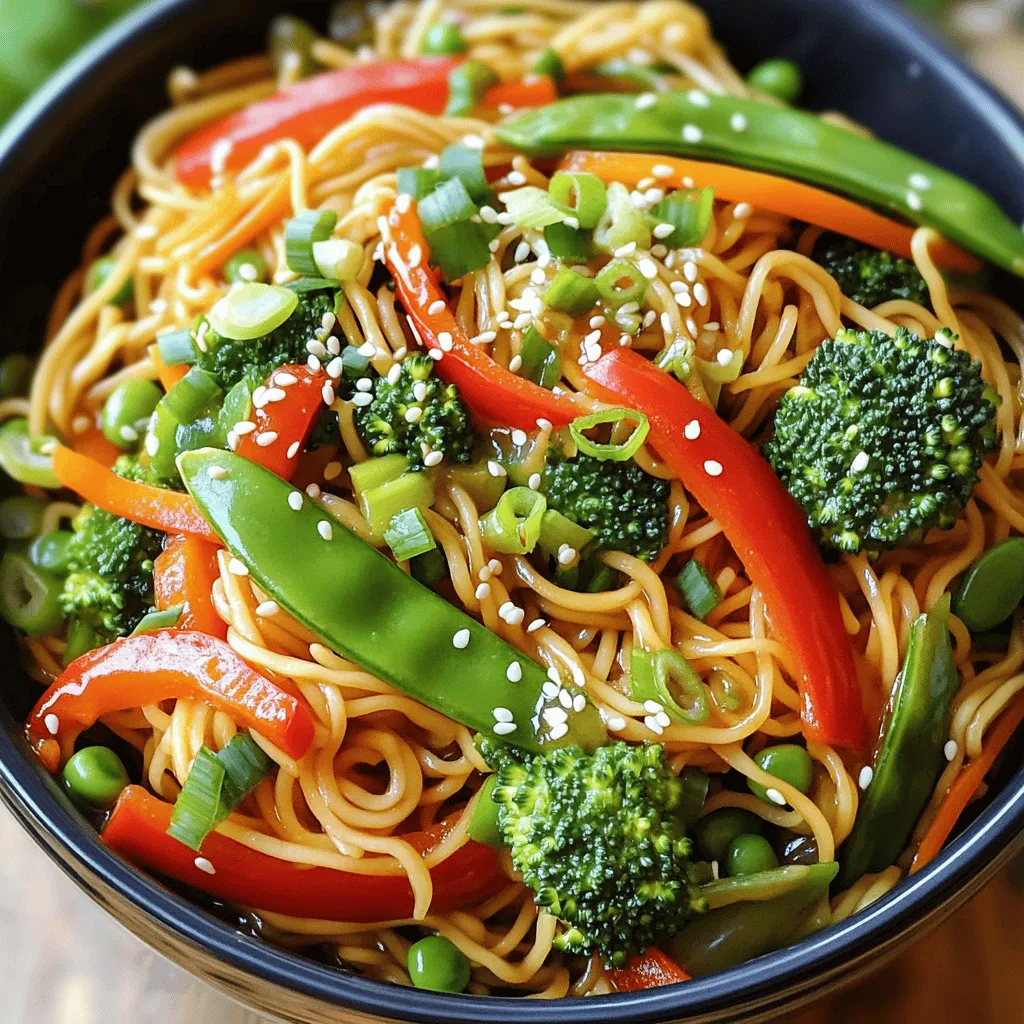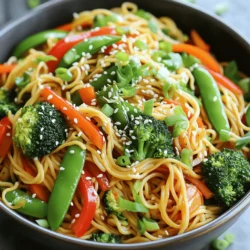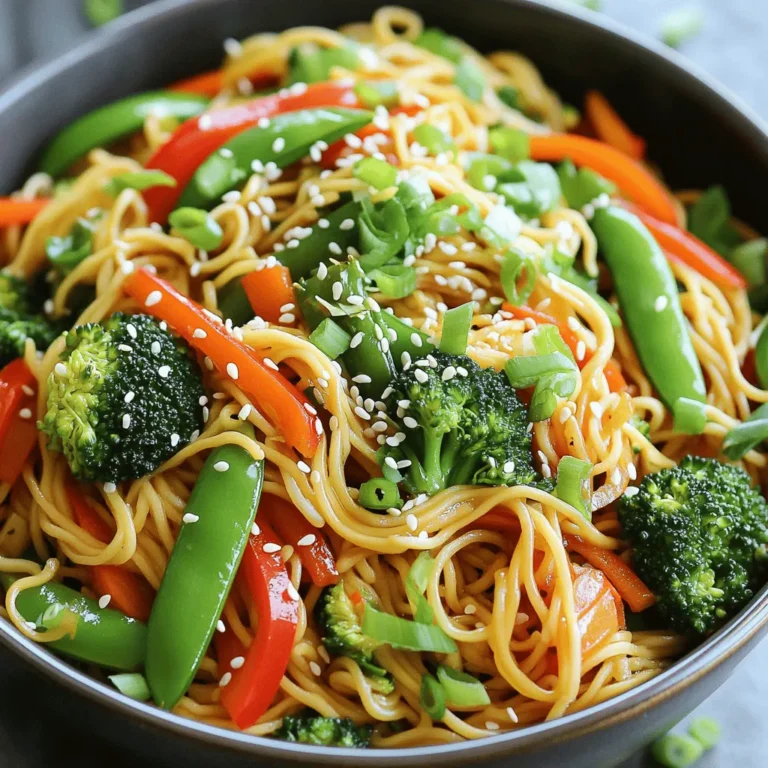If you crave a dish that’s bursting with flavor, you’ve come to the right place! In this Authentic Lo Mein Recipe, I’ll show you how to create this beloved noodle dish in your own kitchen. With fresh vegetables, rich sauces, and simple steps, you’ll savor each bite. Get ready to impress your family and friends with a colorful meal that’s easy to make and unforgettable to taste!
Ingredients
Main Ingredients for Authentic Lo Mein
To make authentic lo mein, you need a few key items. Start with:
- 8 oz lo mein noodles
- 2 tablespoons vegetable oil
- 1 red bell pepper, sliced
- 1 cup broccoli florets
- 1 cup snap peas
- 2 carrots, julienned
- 3 cloves garlic, minced
- 1 inch ginger, grated
- 2 green onions, chopped
- Sesame seeds for garnish
These ingredients create a base rich in flavor and texture. The lo mein noodles are soft and chewy, which is a must for this dish. The fresh veggies add color and crunch.
Essential Sauces and Oils
Next, we need sauces to elevate the taste. The key sauces are:
- 3 tablespoons soy sauce
- 2 tablespoons oyster sauce (or mushroom sauce for a vegetarian option)
- 1 tablespoon sesame oil
Soy sauce gives a salty kick. Oyster sauce adds depth and umami. If you prefer a vegetarian option, mushroom sauce works well too. Sesame oil is the finishing touch, adding a nutty flavor.
Recommended Vegetables for Authentic Flavor
For the best flavor, use fresh, seasonal veggies. I recommend:
- Red bell pepper
- Broccoli florets
- Snap peas
- Carrots
These vegetables not only taste great but also look appealing. They add crunch and sweetness, making your lo mein a delight to eat. You can mix in other veggies like bok choy or mushrooms for more variety.
Step-by-Step Instructions
Cooking the Lo Mein Noodles
To make the perfect lo mein, start with the noodles. Boil a large pot of water. Once it boils, add 8 oz of lo mein noodles. Cook them until they are al dente, which usually takes about 4-5 minutes. After cooking, drain the noodles. Toss them with a bit of sesame oil to keep them from sticking. This step is key for great texture.
Preparing the Vegetables and Aromatics
Next, let’s get the veggies and aromatics ready. Slice 1 red bell pepper and julienne 2 carrots. Chop 1 cup of broccoli florets and 1 cup of snap peas. Mince 3 cloves of garlic and grate 1 inch of ginger. These ingredients bring vibrant colors and flavors. Having them prepped makes cooking easier and faster.
Combining Ingredients for Optimal Flavor
Now for the fun part! Heat 2 tablespoons of vegetable oil in a large skillet or wok over medium-high heat. Add the minced garlic and ginger. Sauté for about 30 seconds until fragrant. Then, toss in your sliced bell pepper, broccoli, snap peas, and carrots. Stir-fry everything for about 5 minutes until the veggies are tender yet crisp.
After the veggies are cooked, add the lo mein noodles. Mix everything well to combine. Then drizzle 3 tablespoons of soy sauce and 2 tablespoons of oyster sauce over the dish. Stir again to ensure the noodles and veggies are coated. Cook for an additional 2-3 minutes for the flavors to meld.
Finally, remove the skillet from heat. Drizzle with 1 tablespoon of sesame oil and add 2 chopped green onions. Toss everything one last time. Your savory vegetable lo mein is almost ready to serve. Plate it up and sprinkle sesame seeds on top for that extra crunch.Enjoy your delicious meal!
Tips & Tricks
Achieving the Perfect Texture
To get lo mein just right, focus on the noodles. Use fresh lo mein noodles if you can find them. They have a great bite and taste. If you use dried noodles, cook them until al dente. That means they should be firm, not soft. Rinse them under cold water after cooking. This helps stop the cooking process. Toss them in sesame oil to keep them from sticking together.
Enhancing Authentic Flavor Profiles
Authenticity shines through simple sauces and fresh ingredients. Soy sauce is a must. It adds saltiness and depth. Oyster sauce brings a hint of sweetness and umami. If you prefer a vegetarian option, use mushroom sauce. Add fresh ginger and garlic for a fragrant base. Using fresh vegetables adds color and crunch. Try a mix of bell peppers, broccoli, and snap peas. This not only tastes great but looks amazing on the plate too.
Timing and Cooking Techniques for Best Results
Timing is key in stir-frying. Start with high heat to get that wok hei flavor. Heat your oil until it shimmers before adding ingredients. Aromatics like garlic and ginger cook fast, so keep an eye on them. Add vegetables in stages, starting with the ones that take longer to cook. Stir-fry quickly to keep them crisp. Finally, combine everything, allowing the flavors to meld without overcooking. For the best flavor, serve immediately after cooking.

Variations
Vegetarian and Vegan Options
You can make a delicious vegetarian or vegan lo mein. Replace the oyster sauce with mushroom sauce. This swap keeps the dish rich and full of flavor. You can add more veggies like bell peppers, mushrooms, and bok choy. These choices add variety and texture. For protein, consider using tofu. Tofu absorbs flavors well, making each bite satisfying.
Protein Add-ins (Chicken, Shrimp, Tofu)
If you want more protein, add chicken or shrimp. Slice chicken breast into thin strips. Cook it in the pan before adding the veggies. For shrimp, toss them in when the veggies are nearly done. If you prefer tofu, use firm tofu. Cut it into cubes and sauté it until golden. This gives a nice crunch and adds a hearty touch.
Regional Variations of Lo Mein
Lo mein varies across regions. In New York, you might find a sweeter sauce. On the other hand, San Francisco styles often use fresh seafood. In China, some regions add spicy chili oil for a kick. Each style brings its unique twist, making lo mein fun to explore. You can try different sauces to match your taste or mood.
Enjoy experimenting with these variations in your authentic lo mein recipe!
Storage Info
How to Store Leftover Lo Mein
To store leftover lo mein, let it cool first. Then, place it in an airtight container. Make sure to keep it in the fridge. It will stay fresh for about three to four days. Label the container with the date. This helps you remember when you made it.
Reheating Tips for Best Results
When you reheat lo mein, the stove is best. Heat a bit of oil in a pan. Add the lo mein and a splash of water. Stir it around over medium heat. This keeps your noodles from getting dry. You can also use a microwave. Cover the bowl with a damp paper towel. This adds moisture while it heats.
Freezing Lo Mein for Later Use
You can freeze lo mein for later meals. First, let it cool down completely. Then, divide it into single servings. Use freezer-safe bags or containers. Remove as much air as possible. Lo mein can stay frozen for up to three months. When you’re ready to eat, thaw it overnight in the fridge.
FAQs
What type of noodles are best for Lo Mein?
I recommend using lo mein noodles for the best results. They are soft and chewy. You can find them in most grocery stores. Fresh noodles give a great texture. Dried noodles work too, but they may need extra cooking time. If you can’t find lo mein noodles, you can use egg noodles as a substitute.
Can I make Lo Mein without oyster sauce?
Yes, you can make Lo Mein without oyster sauce. Use soy sauce as a base for flavor. Many people like to add a splash of mushroom sauce instead. This option gives a nice umami kick. You can also add a bit of hoisin sauce for sweetness. Your dish will still taste delicious without oyster sauce.
How can I make Lo Mein gluten-free?
To make Lo Mein gluten-free, choose gluten-free noodles. Rice noodles are a great option. Make sure to check the labels on sauces. Many soy sauces contain wheat. Use tamari or gluten-free soy sauce instead. This way, you can enjoy the flavors without gluten.
You learned how to make authentic Lo Mein with simple steps and key ingredients. I shared essential tips for perfect texture and rich flavors. You also discovered tasty variations, from vegetarian options to different protein choices. Plus, I covered storage and reheating methods for leftovers.
Making Lo Mein at home is fun and rewarding. With practice, you can impress anyone with your dish. Enjoy cooking and savor the flavors of your homemade Lo Mein!


